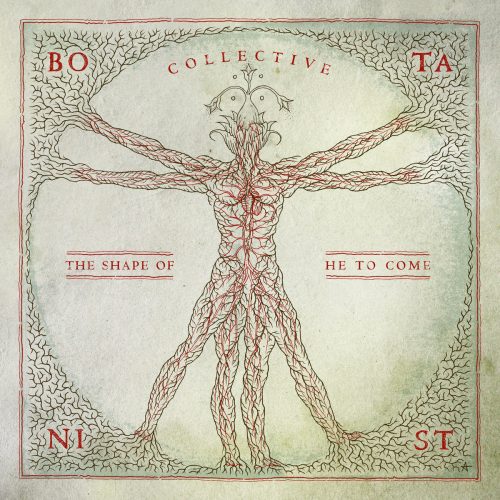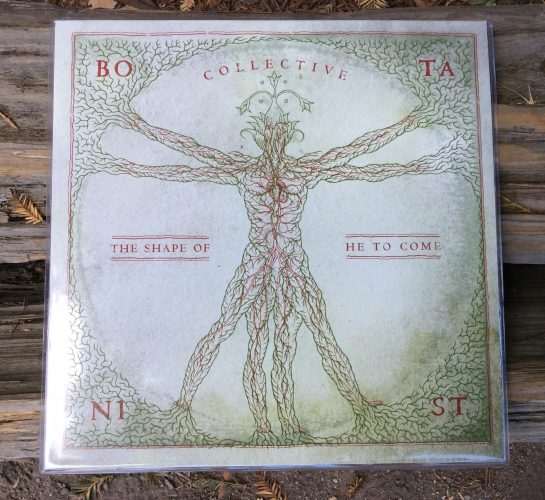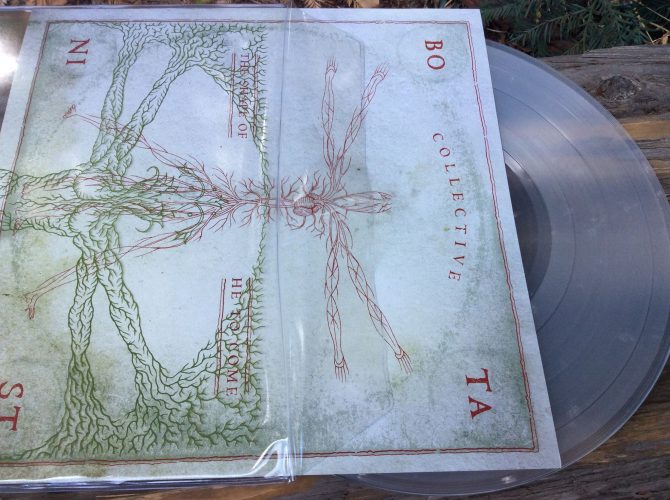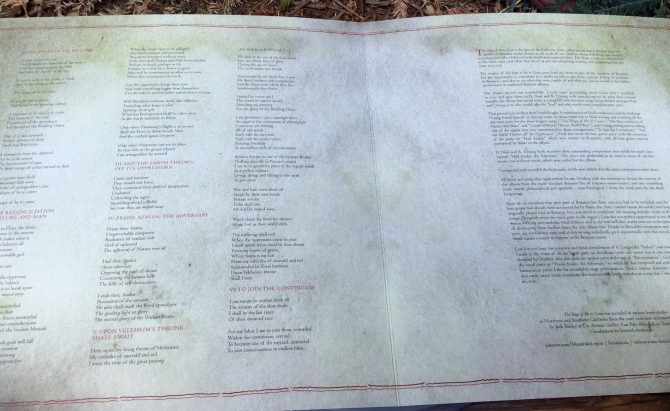It’s likely that after six unique albums and a trio of EPs, Botanist has become known to all discriminating and adventurous metal listeners, of whom you are likely one because you are visiting us now. But in case you are a curious explorer finding your way to Botanist for the first time, we’ll provide a brief introduction before sharing with you the title song from the newest Botanist album — Collective: The Shape of He Who Comes — which will be released on September 1 by Avantgarde Music (CD) and Favonian (LP).
As you will learn, this new album is different from its predecessors in some important ways (though every Botanist album has differed in important ways from its predecessors). And to learn about those differences, and much more about the creative process that produced it as well as Botanist’s future plans, we also present an interview of Botanist’s creator and alter ego Otrebor by an Italian examiner who we’ll call “Mene Frago.”
As our friend Justin Collins put it in his guest review at our site of Botanist’s last release (a 2016 split with Oskoreien), “This isn’t your usual one-man black metal”:
“Otrebor, the creator of the project, is a percussionist at heart, so when it came time to choose the instrument that would be his melodic voice, he went with a stringed/percussive hybrid called a hammered dulcimer. It’s an old instrument — first popularized in the Middle Ages — and it typically features strings stretched over a trapezoid-shaped sounding board….
“But instrumentation is not where the uniqueness ends. Botanist the music entity is the story told by a character known only as The Botanist. To say the least, he is a bit displeased with humankind’s treatment of nature. The Botanist describes a host of plants, often in weaponized terms, that he imagines reasserting the dominance of nature over us destructive humans.”
The Shape of He to Come is the first of the “Collective” series, and it diverges from the model of previous Botanist studio albums in that rather than Otrebor doing everything, it was instead recorded more like a full band, with different responsibilities assigned to different people. A bit further below we have a summary of each person’s contributions to the album, along with the interview, which provides a more in-depth understanding.
The new album also includes thematic divergences from previous releases, which Otrebor describes in the interview we’re presenting.
But let’s turn first to the music you’re about to hear.
“The Shape of He To Come” is torrential, powerful in its striking force, propelled in its most aggressive passages by thundering drumwork, swirls of electrifying melodic and dissonant tones, and bestial vocal rage. But the music reveals other dimensions as it moves, with soaring clean vocal harmonies and cascades of shining melody pulling it in more dreamlike and mystical directions as the blistering pace of the drumming slows.
The dynamic movement between these differing energy levels continues, and the musical textures become even more richly layered and combined in even more inventive ways. The result is a musical experience that’s both shudderingly intense (and even apocalyptic) and completely mesmerizing and transcendental.
Stream “The Shape of He To Come” below, along with “Praise Azalea, the Adversary“, which was the intro that 90% of Botanist shows began with during the years 2013-2016, reworked with vocals.
“THE SHAPE OF HE TO COME”
“PRAISE AZALEA, THE ADVERSARY”
Collective: The Shape of He to Come is available for pre-order now via the Bandcamp links below — vinyl and digital via the first one, and digisleeve CD via the second (digital via both).
Bandcamp:
https://verdant-realm-botanist.bandcamp.com/album/collective-the-shape-of-he-to-come
https://avantgardemusic.bandcamp.com/album/collective-the-shape-of-he-to-come
Facebook:
https://www.facebook.com/Verdant.Realm.Botanist/
PERFORMERS
For The Shape of He To Come, the drums were performed by Otrebor and taken from a pre-existing session from 2010. Those drum recordings were given to two different people who made the dulcimer compositions and performed them — D. Neal (on “The Shape of He to Come,” “The Reconciliation of Nature and Man,” “Praise Azalea, the Adversary,” and “Upon Veltheim’s Throne Shall I Wait”) and R. Chiang (on “Praise Azalea, the Adversary,” “And the Earth Throws off Its Oppressors,” and “To Join the Continuum”).
D. Neal also composed all of the bass parts on the album (except for the parts on “Praise Azalea,” which were composed by Bezaelith). All bass parts on the album were performed by Balan.
Otrebor then composed and recorded the keyboards, wrote all the lyrics and titled the songs. He wrote the melodic vocal lines for “The Shape,” “The Reconciliation,” and “Upon Veltheim,” and performed melodic vocals for these same songs, plus one small harsh vocal doubling of A. Lindo on one section and the spoken-word parts at the end of “Reconciliation.”
Bezaelith performed melodic vocals on all but one song, and wrote the vocal parts for “And the Earth” and “To Join.”
A. Lindo (aka Golem) performed the harsh vocals on the album, and composed his parts for “Praise Azalea,” where he also composed and played the harmonium.
THE INTERVIEW
Do you think your music has made progress over the years? Can you find an album, a song, a period in the past five years that marked a step forward for you in lyrics, music, and production aspects?
Every Botanist full-length is meant to be in some important way an inversion of the album(s) that preceded it. The first (two) albums were fast and thin and with short songs and drums and dulcimer only; the third album is slow and all acoustic; the fourth album is mega fuzzy; the fifth album’s drums were written to the music; the sixth album is dreamy and hazy… The themes and sounds for the seventh through tenth albums has been set for years… up to you to be patient to see what those musical themes are.
Now we’re releasing the first “Collective” album in the Botanist discography, meaning that it’s the first album that was composed and/or performed by Botanist as a group, not a one-man band. The difference in composition and sound is pretty immediately remarkable: I didn’t write or perform any of the dulcimer parts; there’s lots of melodic singing, which is largely because Bezaelith, as a former member of Botanist live, had to be included in the record — but her melodic presence inspired me to further develop the minor forays into singing I had done in previous albums, into something more up front. Successive “Collective” albums are not necessarily going to be such planned “inversions” from one another, but by virtue of “Collective” recordings being made by different lineups, they necessarily will show inherent progressions!
Thematically, The Shape of He to Come diverges entirely away from the template of Botanist songs being about plants, and focuses more on some of the philosophical and mythological aspects of the world within the Verdant Realm — The Verdant Messiah, The Budding Dawn, the floral apocalypse, and the afterlife of The Chlorophyllic Continnum… In this way, The Shape of He to Come is sort of Botanist’s version of an orthodox black green metal album.
Going forward, there will be more “Collective” recordings, including a cassette of the current Botanist lineup performing all the songs it’s learned for 2017. We’ll unveil that at some point within a few weeks of this premiere
One of the main aspect of Botanist is that you play a strange instrument for us, dirty metallers: the dulcimer. What’s a dulcimer? Describe for us the use of the dulcimer in your music and how you improved your technique over the years and over the albums.
A hammered dulcimer is a percussive/string hybrid instrument of sorts, with pairs of strings stretched over a trapezoid box. One hits the strings with small wooden mallets. The instrument is fairly easy to approach for someone like me, who is a drummer / percussively oriented. The instrument is said to trace its roots to the 10th century Middle East, but the so-called “hammered dulcimer” is a traditional Celtic instrument.
In Botanist, the dulcimer replaces what would normally be a guitar. The music is written on dulcimer and drums. Botanist is the first band to have adapted magnetic pickups to a hammered dulcimer, and to play the instrument through distorted amplifiers, on stage, in a metal setting.
The dulcimer could draw some classical sounds, also more authentic than a harpsichord or a piano. Are symphonic and classical music important to Botanist?
Definitely. The music of Vivalid, Bach, and Pärt are as much an influence on Botanist as any metal band. Certainly a huge amount of metal bands owe a lot to those three composers alone.
Do you think Botanist is a metal band? Metal Archives refuses to admit Botanist…
A minor part of Botanist’s inversion of black metal is to challenge the notion that guitar in a metal band is a foregone conclusion — that “guitar” and “metal” are inseparable. Metal is, after all, in an important way about brashly challenging the establishment, and black metal in particular is the voice of the adversary. Then let Botanist challenge the establishment that is Metal Archives.
Who’s the person that gave you more inspiration for Botanist and your way of playing music? Maybe someone you worked with, like Balan from Palace of Worms?
I think the person that had the biggest direct influence on Botanist was a singing teacher I had more than 10 years ago. I didn’t necessarily learn that much about singing from her, but she gave me some very important and liberating musical outlooks, that I repeat to this day, and likely will repeat for as long as I create. One is “no matter how bad it is, someone will like it.” The other is, “when you make music, you do whatever until it sounds right, and that’s what the song becomes.”
Working with Balan was totally great, by the way, and I’m sad he’s not currently in the live band at this time.
How did you find other musicians for the live band?
Lineup 1.0-1.2 (from 2013-2015) formed largely thanks to the website The Quietus, who did a very fine interview with me. D. Neal was the right person at the right time to have read that interview in that not only was he a dulcimer player, but was also a black metal fan. He got his drummer friend R. Chiang to be excited enough to buy his own dulcimer and learn to play it for Botanist. Those two were based in Southern California, which made practice and local shows a big challenge.
The rest of the lineup were friends and acquaintances of mine in the Bay Area, Bezaelith, who originally tried out for a thrash project I was trying to get off the ground in 2008, and then of course went on to co-create Lotus Thief with me, and “Golem” A. Lindo, who was a friend of a friend who became a friend and bandmate. I met Balan (who filled in for both D. Neal on dulcimer and Bezaelith on bass on two separate tours) via The Flenser, whose first release was the debut Palace of Worms full-length. I interviewed Balan for the webzine I ran at the time, and our friendship has grown from there. This group of above people is the one featured on Collective: The Shape of He to Come. The lineup is
Otrebor — drums, clean vocals
Neal — dulcimer
Chiang — dulcimer
Lindo — harsh vocals and harmonium
Balan — bass guitar
Bezaelith — clean vocals
Lineup 2.0 is all people in the Bay Area, thankfully. One guy is in my friend’s hardcore / powerviolence band, Concrete Walls, whom I did a short tour with when I was in Lotus Thief. The other two guys are composed of a very outstanding bass player I’ve had the pleasure of knowing for 15 years (he was in a very early project I drummed for) and the drummer of his technical/prog death metal band, Sentient Ignition.
We had a fifth member for the first six months of Botanist Live 2.0, a member of Kayo Dot, who alarmingly had to drop out as he was diagnosed with cancer — something that was “luckily” detected earlier that it might have as he wanted a clean bill of health from his doctor before he went on a major tour. The people I have on stage have all been wonderful fits musically and personality-wise in the group.
Botanist’s current lineup is
Otrebor — dulcimers
Toorpand — bass guitar
Daturus — drums
Cynoxylon — vocals and harmonium
How is Botanist live? What reactions do you notice in people who listen to you for the first time?
I keep getting reminded of one of my favorite sayings, “no matter how bad it is, someone will like it,” when playing live with Botanist. To me, it’s still a little uncomfortable that Botanist live is not able to replicate the sound and mood of Botanist on record, and I am rarely satisfied with the live performances. However, many people who would have no personal stake in these matters have said how great their experience witnessing Botanist live has been — when it gets to the level of the superlative it makes me wonder how many shows they’ve been to before… but I’m not going to argue and I humbly say thank you.
This has to do with another important musical lesson that I learned, this time from Paul Bostaph, the great thrash metal drummer who is in / has been in Slayer, Exodus, Forbidden, and Testament, and whom I took lessons from many years ago. Paul is without a doubt one of the best at what he does, and he’s influenced a very large amount of current mega talents. However, I remember him telling me how although he believed he’d mastered the “caveman” style of drumming, he was by no means a drum master… but that didn’t matter. What mattered was to go on stage and give a great, capable performance, one that had enthusiasm and energy… that even if he maybe was or was not actually the best drummer, his energy made the audience believe he was. If they left thinking that he gave a great, memorable show, that’s what mattered — far more than technical ability. That lesson is very important in my approaching the live aspect of Botanist. It’s not up to me to decide for someone else if they liked the show: If they liked it, then we did a good job, regardless of whether I liked it or not.






Hi,
I’m the Italian guy. It’s Meni Frago, that’s my surname, split in half and then inverted 😉
Now write about music on my small virtual home called Blog Thrower
https://blogthrower.wordpress.com
Thanks for sharing
Thanks for allowing Otrebor to share your interview with us.